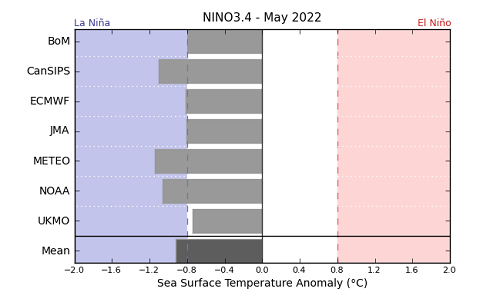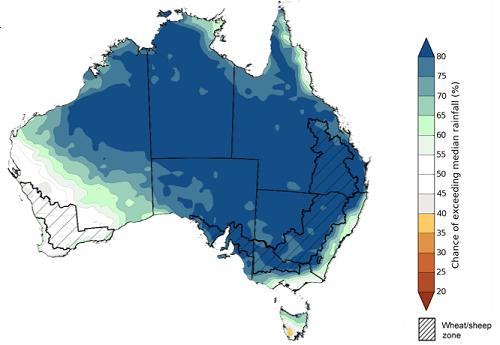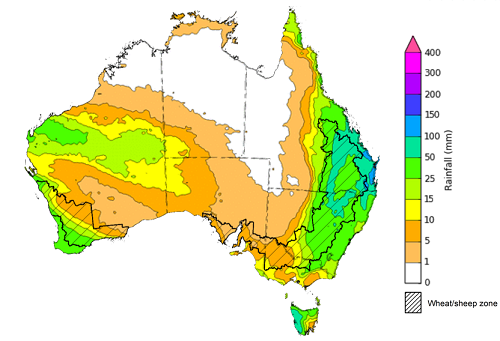Key issues
- For the week ending 11 May 2022, an intense low-pressure trough across eastern Australia has resulted in significant rainfall in the north-east of the country, with an occluded front bringing heavy falls to the south-east. In remaining parts of the country, high-pressure systems dominated, providing clear, dry conditions.
- Dry conditions across cropping regions in New South Wales, Victoria, South Australia and Western Australia have allowed the planting of winter crops to continue. Most growers have completed sowing canola and faba beans and are making a good progress on wheat and barley planting. In New South Wales, the dry conditions will also have allowed harvesting of long-season summer crops to progress. For much of Queensland, recent rainfall likely interrupted the harvesting of summer crops and planting of winter crops.
- The 2021–22 La Niña event continues to weaken, with oceanic indicators mostly at neutral levels. However, atmospheric indicators remain above La Niña thresholds, meaning La Niña's influence continues. The Indian Ocean Dipole (IOD) is currently neutral. All climate model outlooks surveyed suggest a negative IOD may develop in the coming months. A negative IOD increases the chances of above average winter–spring rainfall for much of Australia. The SAM index is currently positive and is forecast to remain positive for the coming four weeks. A positive SAM often has a drying influence for parts of southwest and southeast Australia.
- The outlook for June 2022 indicates that there is a 75% chance of rainfall totals between 10 and 50 millimetres across New South Wales, scattered areas of Queensland, Victoria, southern South Australia, the southwest of Western Australia and Tasmania. Rainfall totals in excess of 100 millimetres are expected across alpine regions of New South Wales and Victoria, as well as the far southwest of Western Australia and western Tasmania.
- Over the 8-days to 19 May 2022, low-pressure troughs are expected to result in continued heavy rainfall across eastern Australia, with cold-fronts bringing rainfall to parts of Western Australia and Tasmania. High-pressure systems in remaining parts of the country will bring mostly dry conditions. The continuation of wet conditions across Queensland will add to the above average soil moisture levels, restricting field access and further delaying harvesting and planting activities. Likewise, the wet conditions over the next 8 days in New South Wales are likely to restrict field access, preventing the harvest of cotton as well as the planting of winter crops.
- Water storage in the Murray–Darling Basin (MDB) increased by 36 gigalitres (GL) between 4 May 2022 and 11 May 2022. The current volume of water held in storage is 21,562GL, which represents 85% of total capacity. This is 50% or 7,223 GL more than at the same time last year.
- Allocation prices in the Victorian Murray below the Barmah Choke decreased from $52 per ML on 29 April 2022 to $43 per ML on 6 May 2022. Prices are lower in the Goulburn-Broken, Murrumbidgee and regions above the Barmah choke due to the binding of the Goulburn intervalley trade limit, Murrumbidgee export limit and Barmah choke trade constraint.
Climate
For the week ending 11 May 2022, an intense low-pressure trough across eastern Australia has resulted in significant rainfall in the north-east of the country, with an occluded front bringing heavy falls to the south-east. In remaining parts of the country, high-pressure systems dominated, providing clear, dry conditions.
Rainfall totals of between 10 and 50 millimetres were recorded across northern and parts of eastern New South Wales, much of Queensland and Tasmania, parts of southern Victoria and eastern South Australia, as well as isolated parts of Western Australia and the Northern Territory. Rainfall totals in excess of 50 millimetres were recorded across southern and central Queensland and southern Tasmania. Remaining parts of Australia received little to no rainfall.
In cropping regions, rainfall totals of between 10 and 50 millimetres were recorded across northern New South Wales and much of southern Queensland. Rainfall in excess of 50 millimetres was recorded in cropping regions in parts of southern and much of northern Queensland. Little to no rainfall was recorded across cropping regions in remaining parts of New South Wales, Victoria, South Australia and Western Australia.
Dry conditions across cropping regions in New South Wales, Victoria, South Australia and Western Australia have allowed the planting of winter crops to continue. Most growers have completed sowing canola and faba beans and are making a good progress on wheat and barley planting. In New South Wales, the dry conditions will also have allowed harvesting of long-season summer crops to progress. For much of Queensland, recent rainfall likely interrupted the harvesting of summer crops and planting of winter crops. After a relatively dry summer, Central Queensland received substantial rainfall over the past week. The rainfall may cause quality issues for unharvested summer crops but will provide a boost to soil moisture levels heading into winter.
Rainfall for the week ending 11 May 2022
Note: The rainfall analyses and associated maps utilise data contained in the Bureau of Meteorology climate database, the Australian Data Archive for Meteorology (ADAM). The analyses are initially produced automatically from real-time data with limited quality control. They are intended to provide a general overview of rainfall across Australia as quickly as possible after the observations are received. For further information go to http://www.bom.gov.au/climate/rainfall/
Throughout late autumn and early winter, the climate drivers with the largest potential impact on Australia’s climate patterns are the El Niño–Southern Oscillation (ENSO), the Indian Ocean Dipole (IOD) and the Southern Annular Mode (SAM). These climate drivers are likely to influence pasture growth across southern Australia and the germination and growth for winter crops.
The 2021–22 La Niña event continues to weaken, with oceanic indicators mostly at neutral levels. However, atmospheric indicators remain above La Niña thresholds, meaning La Niña's influence continues. La Niña events are typically associated with above average rainfall across large parts of eastern Australia during late autumn and early winter. Even as the event weakens, it is expected to continue influencing climate patterns in Australia over the coming months.
The IOD is currently neutral. All climate model outlooks surveyed suggest a negative IOD may develop in the coming months. A negative IOD increases the chances of above average winter–spring rainfall for much of Australia.
The SAM index is currently positive and is forecast to remain positive for the coming four weeks. During autumn SAM typically has a weaker influence on Australian rainfall, but as we approach winter, a positive SAM often has a drying influence for parts of southwest and southeast Australia.
Below average sea surface temperature (SST) anomalies have persisted and strengthened slightly along the equator in the central Pacific Ocean. Meanwhile, warm SST anomalies throughout the Maritime Continent have weakened slightly. Warm sub-surface water temperature anomalies have strengthened slightly in the eastern Pacific Ocean, foreshadowing the breakdown of the current La Niña event.
Difference from average sea surface temperature observations 2 to 8 May 2022
International climate model outlooks for the NINO 3.4 region in May 2022
Most climate models surveyed by the Bureau of Meteorology expect the La Niña event to continue throughout May, with three of the seven models expecting it to remain active in June 2022. ENSO events are usually most active throughout spring and summer, then decay and return to neutral conditions in autumn. For the period ending 8 May 2022, the 30-day SOI was +20.7 and the 90-day SOI was +14.2, both well above the La Niña threshold of +7. Trade winds were stronger than average in the western Pacific but have returned to average strength in the eastern Pacific, and cloudiness near the Date Line remains below average. These indications are consistent with the ongoing La Niña event.
30-day Southern Oscillation Index (SOI) values ending 9 May 2022
The Indian Ocean Dipole (IOD) is currently neutral. As at 8 May 2022, the IOD weekly value was +0.13°C. The majority of international climate models surveyed by the Bureau of Meteorology indicate a negative IOD event could develop by June. While model outlooks have low accuracy at this time of year and hence some caution should be taken with IOD outlooks beyond May, there is strong forecast consistency across international models.
International climate model outlooks for the ION index in June 2022
The Southern Annular Mode (SAM) is currently positive and is expected to remain mostly positive for the next four weeks. The SAM refers to the north-south shift of the band of rain-bearing westerly winds and weather systems in the Southern Ocean compared to the usual position.
Southern Annular Mode (SAM) daily index
These climate outlooks are generated by ACCESS–S (Australian Community Climate Earth-System Simulator–Seasonal). ACCESS–S is the Bureau of Meteorology's dynamical (physics-based) weather and climate model used for monthly, seasonal and longer-lead climate outlooks.
For further information, go to http://www.bom.gov.au/climate/ahead/about/
The Bureau of Meteorology’s latest rainfall outlook indicated wetter than average conditions are expected across the majority of Australia during June. The ACCESS-S climate model suggests there is close to a 65% chance of exceeding median for most of Australia, while the south-west and far south-east of Australia have roughly equal chances of being above or below median.
The outlook for June 2022 indicates that there is a 75% chance of rainfall totals between 10 and 50 millimetres across New South Wales, south-east Queensland, Victoria, southern South Australia, the southwest of Western Australia and Tasmania. Rainfall totals in excess of 100 millimetres are expected across alpine regions of New South Wales and Victoria, as well as the far southwest of Western Australia and western Tasmania.
Across cropping regions there is a 75% chance of rainfall totals of between 25 and 50 millimetres across most of New South Wales, Victoria, South Australia and the west and south of Western Australia. There is a 75% chance of rainfall less than 25 millimetres for northwest Victoria, most of Queensland, and eastern cropping regions in Western Australia.
Rainfall totals that have a 75% chance of occurring June 2022
The rainfall outlook for June to August 2022 suggests there is a greater than 70% chance of exceeding median rainfall across most of New South Wales, Queensland, South Australia, northern Victoria, the north of Western Australia, as well as the Northern Territory. For remaining regions of Australia, there is roughly an equal chance of above and below median rainfall between June to August 2022 (Bureau of Meteorology ‘National Climate Outlook’, 5 May 2022).
Bureau of Meteorology rainfall outlooks for June to August have greater than 55% past accuracy across most of Australia. Outlook accuracy is greater than 65% across large areas of western and eastern Australia.
Chance of exceeding the median rainfall June to August 2022
The outlook for June to August 2022 suggests there is a 75% chance of rainfall totals between 50 and 200 millimetres across much of New South Wales, south-eastern Queensland, Victoria, southern parts of South Australia, the south-west of Western Australia and Tasmania. Rainfall totals in excess of 200 millimetres are forecast for alpine regions of New South Wales and Victoria, the far southwest of Victoria, the far southeast of South Australia, the far south-west of Western Australia, and western and northern Tasmania.
Across cropping regions, there is a 75% chance of receiving between 50 and 100 millimetres across much of Queensland, northern Victoria, parts of eastern South Australia and eastern Western Australia. Totals of between 100 and 200 millimetres are expected across much of New South Wales, parts of southern Queensland, southern Victoria, central and western South Australia and western and southern Western Australia.
Root zone soil moisture levels are average to above average across much of the Wheat/sheep zone but below average to average across parts of South Australia and Western Australia. There is a high—75%—chance that forecast rainfall totals in northern cropping regions will be sufficient to support the establishment of winter crops. In remaining cropping regions, the expectation of close to average rainfall over the next three months is likely to provide an ideal start to the winter cropping season, particularly in areas with average or better soil moisture levels for this time of year.
Rainfall totals that have a 75% chance of occurring June to August 2022
The temperature outlook for June to August 2022 indicates that maximum temperatures across most of Australia are likely to be close to the 1990-2012 average (- 1°C to 1°C), with slightly higher than average temperatures across the tropical north. Minimum temperatures are expected to be slightly above average for much of the northern and eastern Australia, and close to average for the rest of Australia (Bureau of Meteorology ‘National Climate Outlook’, 5 May 2022).
Predicted maximum temperature anomaly for June to August 2022
Predicted minimum temperature anomaly for June to August 2022
Over the 8-days to 19 May 2022, low-pressure troughs are expected to result in continued heavy rainfall across eastern Australia, with cold-fronts bringing rainfall to parts of Western Australia and Tasmania. High-pressure systems in remaining parts of the country will bring mostly dry conditions.
Rainfall totals of between 10 and 50 millimetres are forecast for much of central and eastern New South Wales, eastern Queensland, isolated parts of Victoria, South Australia and the Northern Territory, as well as south-west and central Western Australia and much of Tasmania. Rainfall in excess of 50 millimetres is expected for north-eastern New South Wales, south-eastern Queensland and western Tasmania.
In Australian cropping regions, rainfall totals of between 10 and 50 millimetres are expected across New South Wales and Queensland, eastern Victoria, as well as southern and western parts of Western Australia. Rainfall in excess of 50 millimetres is expected across parts of northern New South Wales and much of Queensland. Little to no rainfall is forecast for all remaining cropping regions during the next 8-days.
The continuation of wet conditions across Queensland will add to the above average soil moisture levels, restricting field access and further delaying harvesting and planting activities. Likewise, the wet conditions over the next 8 days in New South Wales are likely to restrict field access, preventing the harvest of cotton as well as the planting of winter crops. For unharvested summer crops, the expected rainfall is too late to support yield potentials and may contribute to quality downgrades if wet conditions continue.
For much of Victoria, South Australia and Western Australia, planting activity is expected to continue, as growers begin planting wheat and barley. Above average rainfall is expected across eastern growing regions, and growers will be looking to complete harvesting and planting activities as quickly as possible. Central areas of South Australia are still yet to receive significant opening rainfall for the winter cropping season, but dry-sowing of crops is reported to be underway.
Total forecast rainfall (mm) for the period 12 May to 19 May 2022
Water
Water storages, water markets and water allocations - current week
The Tableau dashboard may not meet accessibility requirements. For information about the contents of these dashboards contact ABARES.
Commodities
Information on weekly price changes in agricultural commodities is now available at the Weekly commodity price update.












